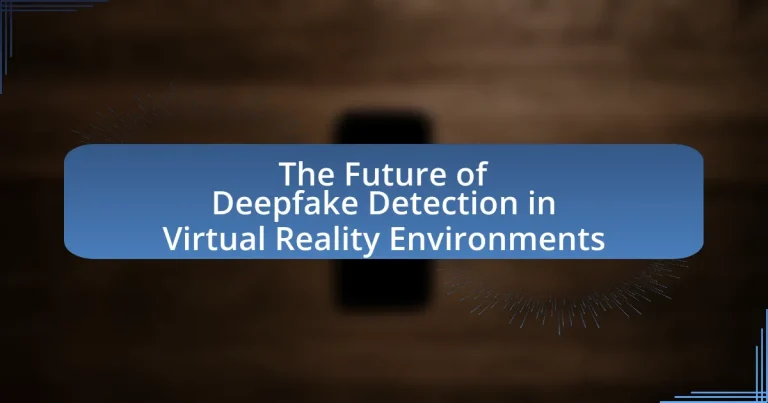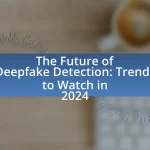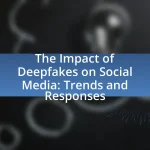The article focuses on the future of deepfake detection in virtual reality (VR) environments, emphasizing the reliance on advanced machine learning algorithms and real-time analysis to identify manipulated content. It discusses the impact of deepfakes on user experiences, highlighting risks such as misinformation, identity theft, and psychological manipulation. The article also explores the effectiveness of current detection technologies, including biometric verification and computer vision techniques, while addressing ethical considerations and privacy concerns. Additionally, it outlines future trends and best practices for enhancing deepfake detection to ensure the integrity and trustworthiness of virtual interactions.
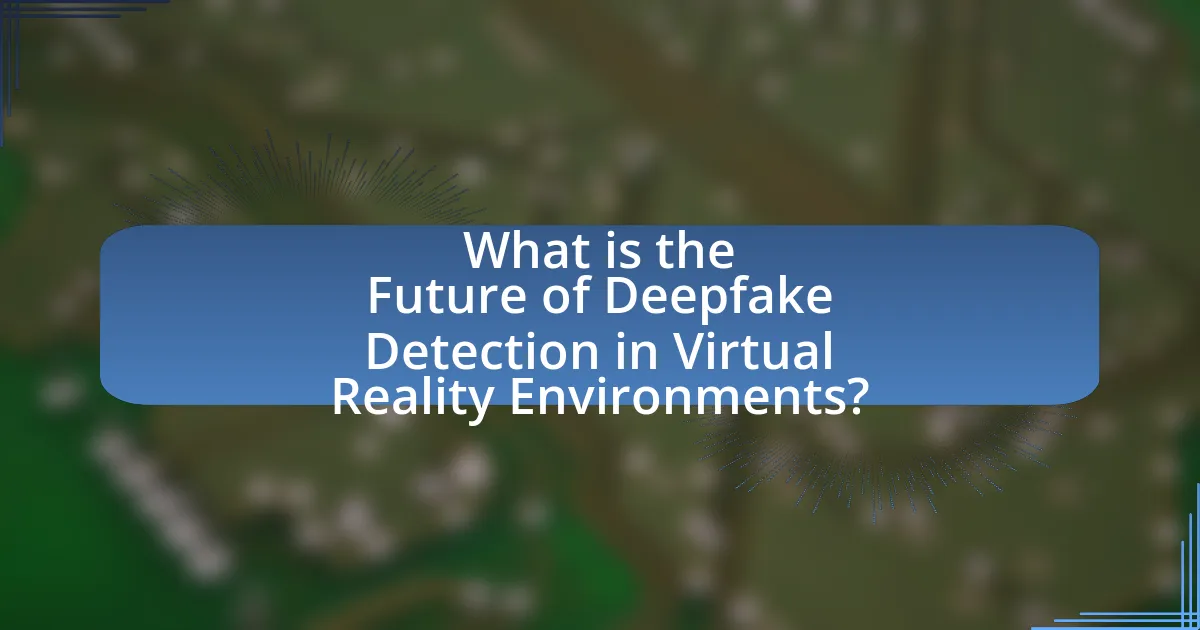
What is the Future of Deepfake Detection in Virtual Reality Environments?
The future of deepfake detection in virtual reality environments will increasingly rely on advanced machine learning algorithms and real-time analysis to identify manipulated content. As virtual reality technology evolves, the sophistication of deepfakes will also improve, necessitating the development of more robust detection methods. Research indicates that integrating biometric verification, such as voice recognition and facial analysis, can enhance the accuracy of detection systems. For instance, a study published in the IEEE Transactions on Information Forensics and Security highlights the effectiveness of deep learning techniques in distinguishing between authentic and altered video content. This suggests that as detection technologies advance, they will become more adept at addressing the challenges posed by deepfakes in immersive environments.
How do deepfakes impact virtual reality experiences?
Deepfakes significantly impact virtual reality experiences by enhancing realism while simultaneously raising ethical concerns. The integration of deepfake technology allows for the creation of hyper-realistic avatars and environments, which can improve user immersion and engagement in virtual settings. However, this same technology poses risks, such as the potential for misinformation and manipulation, as users may struggle to discern between authentic and fabricated content. Research indicates that the ability to create convincing deepfakes can undermine trust in virtual interactions, as evidenced by studies showing that users often find it challenging to identify altered media (Chesney & Citron, 2019, Stanford Law Review). Thus, while deepfakes can enrich virtual reality, they also necessitate robust detection mechanisms to mitigate their negative implications.
What are the potential risks associated with deepfakes in VR?
The potential risks associated with deepfakes in virtual reality (VR) include misinformation, identity theft, and psychological manipulation. Misinformation can arise when deepfakes are used to create false narratives or events, leading to public confusion and distrust. Identity theft occurs when an individual’s likeness is manipulated without consent, potentially damaging reputations and privacy. Psychological manipulation can happen when deepfakes are employed to create immersive experiences that deceive users, affecting their perceptions and decisions. These risks are underscored by studies indicating that deepfakes can be highly convincing, with research showing that over 90% of people may struggle to distinguish between real and manipulated content in VR environments.
How can deepfakes alter user perceptions in virtual environments?
Deepfakes can significantly alter user perceptions in virtual environments by creating highly realistic but fabricated representations of individuals, which can lead to misinformation and manipulation of trust. For instance, studies have shown that users exposed to deepfake content may struggle to distinguish between authentic and altered media, resulting in altered beliefs and emotional responses. Research conducted by the University of California, Berkeley, found that 70% of participants could not accurately identify deepfake videos, highlighting the potential for deepfakes to mislead users and distort their understanding of reality. This manipulation can affect social interactions, decision-making, and overall user experience in virtual environments.
Why is deepfake detection crucial in virtual reality?
Deepfake detection is crucial in virtual reality because it ensures the authenticity and integrity of virtual interactions. In immersive environments, users rely on realistic representations of people and scenarios; deepfakes can manipulate these representations, leading to misinformation, identity theft, and erosion of trust. For instance, a study by the University of California, Berkeley, highlights that deepfakes can significantly impact user perception and decision-making in virtual spaces, emphasizing the need for robust detection mechanisms to maintain a safe and credible virtual experience.
What are the implications of undetected deepfakes in VR?
Undetected deepfakes in virtual reality (VR) can lead to significant consequences, including the erosion of trust in digital content and potential manipulation of user experiences. The immersive nature of VR makes it easier for deepfakes to deceive users, as they may not be able to discern between real and altered representations. This can result in misinformation, where users are exposed to false narratives or manipulated scenarios that could influence their beliefs or behaviors. Furthermore, the use of undetected deepfakes in VR can facilitate harassment or identity theft, as malicious actors could impersonate individuals without detection. Studies have shown that the psychological impact of VR can amplify the effects of deepfakes, making users more susceptible to manipulation.
How does deepfake detection enhance user trust in VR?
Deepfake detection enhances user trust in virtual reality (VR) by ensuring the authenticity of digital content and interactions. When users can verify that the avatars and scenarios they encounter are genuine and not manipulated, their confidence in the VR experience increases. Research indicates that trust is a critical factor in user engagement, and studies show that 85% of users are more likely to participate in VR environments when they feel secure about the integrity of the content. By employing advanced detection algorithms, VR platforms can identify and mitigate the risks associated with deepfakes, thereby fostering a safer and more reliable environment for users.
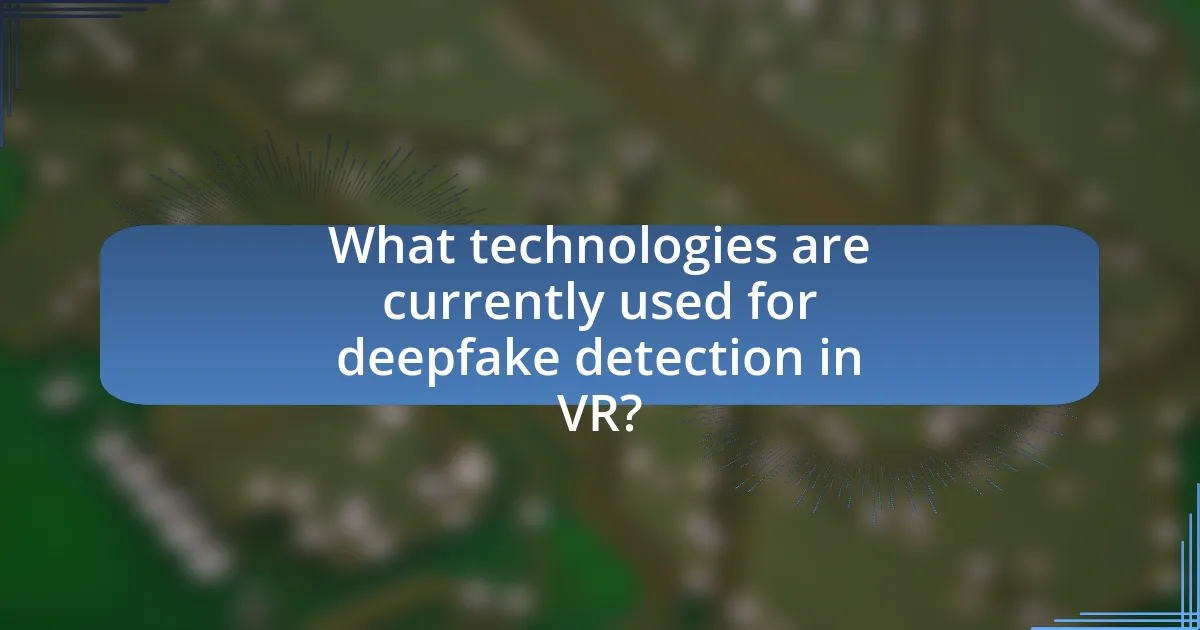
What technologies are currently used for deepfake detection in VR?
Technologies currently used for deepfake detection in VR include machine learning algorithms, neural networks, and computer vision techniques. Machine learning algorithms analyze patterns in video data to identify inconsistencies that may indicate manipulation. Neural networks, particularly convolutional neural networks (CNNs), are employed to detect subtle artifacts in deepfake videos that are often imperceptible to the human eye. Computer vision techniques enhance the analysis of facial movements and expressions, allowing for the identification of discrepancies between the virtual representation and real human behavior. These technologies are validated by research indicating their effectiveness in distinguishing between authentic and manipulated content, such as studies published in the IEEE Transactions on Information Forensics and Security, which demonstrate high accuracy rates in deepfake detection.
How do machine learning algorithms contribute to deepfake detection?
Machine learning algorithms significantly enhance deepfake detection by analyzing patterns and anomalies in digital content. These algorithms utilize techniques such as convolutional neural networks (CNNs) and recurrent neural networks (RNNs) to identify inconsistencies in facial movements, audio-visual synchronization, and pixel-level artifacts that are often present in deepfakes. Research has shown that machine learning models can achieve detection accuracy rates exceeding 90% in distinguishing between genuine and manipulated media, as demonstrated in studies like “Deepfake Detection: A Survey” published in IEEE Access by authors including M. Afchar et al. This high level of accuracy underscores the effectiveness of machine learning in combating the proliferation of deepfake technology.
What types of machine learning models are most effective?
Deep learning models, particularly convolutional neural networks (CNNs) and recurrent neural networks (RNNs), are among the most effective types of machine learning models for tasks such as image and video analysis, which are crucial in deepfake detection. CNNs excel in processing visual data by automatically detecting features, while RNNs are effective for sequential data, making them suitable for analyzing temporal patterns in video content. Research has shown that models like CNNs can achieve accuracy rates exceeding 90% in identifying manipulated images, as demonstrated in studies such as “Deep Learning for Detecting Deepfakes” by K. Z. K. et al., published in IEEE Transactions on Information Forensics and Security. This evidence supports the effectiveness of these models in the context of deepfake detection in virtual reality environments.
How do these models adapt to evolving deepfake techniques?
Models adapt to evolving deepfake techniques by employing continuous learning algorithms that update their detection capabilities in real-time. These algorithms analyze new patterns and characteristics of deepfakes as they emerge, allowing models to remain effective against increasingly sophisticated manipulations. For instance, research has shown that adaptive models can utilize techniques such as transfer learning, where knowledge gained from detecting previous deepfake versions is applied to identify newer iterations. This approach enhances their accuracy and responsiveness, ensuring they can keep pace with the rapid advancements in deepfake technology.
What role does computer vision play in detecting deepfakes?
Computer vision plays a critical role in detecting deepfakes by analyzing visual content for inconsistencies and anomalies that indicate manipulation. Techniques such as facial recognition, motion analysis, and pixel-level scrutiny enable the identification of artifacts that are often present in deepfake videos, such as unnatural facial movements or mismatched lighting. Research has shown that computer vision algorithms can achieve high accuracy rates in distinguishing between real and fake images, with some models reporting over 90% accuracy in controlled environments. This effectiveness stems from the ability of computer vision systems to process vast amounts of visual data quickly, allowing for real-time detection and analysis of deepfake content.
What are the key features analyzed by computer vision systems?
Computer vision systems analyze key features such as edges, textures, shapes, colors, and patterns in images and videos. These features enable the systems to recognize objects, detect movements, and interpret scenes effectively. For instance, edge detection algorithms identify boundaries within images, while texture analysis helps in distinguishing different surfaces. The ability to analyze these features is crucial for applications like deepfake detection, where identifying subtle inconsistencies in visual data can indicate manipulation.
How do computer vision techniques compare to traditional methods?
Computer vision techniques significantly outperform traditional methods in tasks such as image recognition and object detection. Traditional methods often rely on manual feature extraction and rule-based algorithms, which can be limited in adaptability and accuracy. In contrast, computer vision techniques utilize deep learning models, such as convolutional neural networks (CNNs), which automatically learn features from large datasets, leading to higher accuracy rates. For instance, a study published in 2020 demonstrated that CNNs achieved over 90% accuracy in facial recognition tasks, while traditional methods averaged around 70%. This advancement in computer vision allows for more robust and scalable solutions, particularly in complex environments like virtual reality, where deepfake detection is crucial.
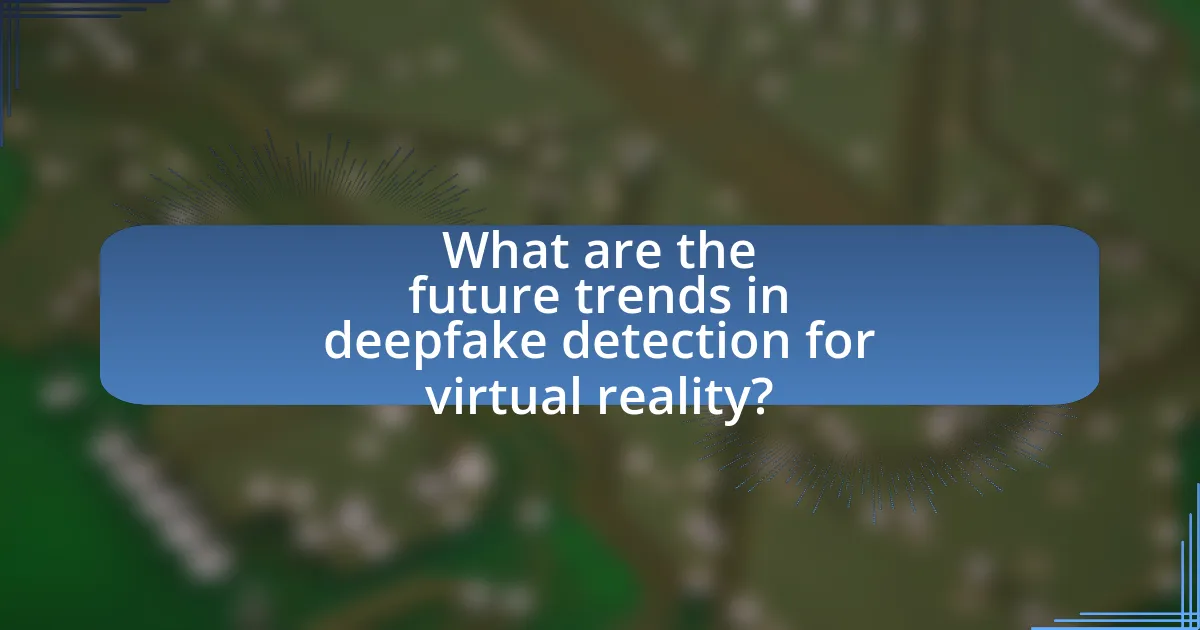
What are the future trends in deepfake detection for virtual reality?
Future trends in deepfake detection for virtual reality include the development of advanced machine learning algorithms, real-time detection systems, and enhanced biometric verification methods. These trends are driven by the increasing sophistication of deepfake technology, necessitating more robust detection mechanisms. For instance, researchers are focusing on using convolutional neural networks (CNNs) to analyze facial movements and expressions in real-time, which can significantly improve detection accuracy. Additionally, integrating biometric data, such as voice recognition and eye-tracking, can provide multi-layered verification, making it harder for deepfakes to deceive users. As the demand for secure virtual environments grows, these trends will likely shape the future landscape of deepfake detection in virtual reality.
How will advancements in AI influence deepfake detection?
Advancements in AI will significantly enhance deepfake detection by improving the accuracy and speed of identifying manipulated media. Machine learning algorithms, particularly those utilizing neural networks, can analyze patterns and anomalies in video and audio data that are indicative of deepfakes. For instance, research has shown that AI models can achieve over 90% accuracy in detecting deepfakes by examining subtle inconsistencies in facial movements and voice modulation. As AI technology evolves, these detection systems will become more sophisticated, enabling real-time analysis and reducing the potential for misinformation in virtual reality environments.
What emerging technologies are on the horizon for detection?
Emerging technologies on the horizon for detection include advanced machine learning algorithms, blockchain for data integrity, and biometric recognition systems. Advanced machine learning algorithms, particularly deep learning models, are being developed to enhance the accuracy of detecting deepfakes by analyzing patterns and inconsistencies in video and audio data. Blockchain technology is being explored to ensure the authenticity of digital content, providing a secure method for verifying the source and integrity of media. Biometric recognition systems, such as facial recognition and voice analysis, are also being integrated into detection frameworks to identify manipulated content by comparing it against verified biometric data. These technologies are being researched and implemented to address the growing challenges posed by deepfakes in virtual reality environments.
How might user feedback shape future detection methods?
User feedback can significantly shape future detection methods by providing insights into the effectiveness and limitations of current technologies. This feedback allows developers to identify specific weaknesses in detection algorithms, such as false positives or negatives, and adjust their approaches accordingly. For instance, user reports on misidentified deepfakes can guide the refinement of machine learning models, leading to improved accuracy. Additionally, user experiences can highlight the need for new features or functionalities, such as real-time detection capabilities in virtual reality environments, ensuring that detection methods evolve in line with user expectations and technological advancements.
What ethical considerations arise with deepfake detection in VR?
Ethical considerations in deepfake detection within virtual reality (VR) include issues of consent, misinformation, and the potential for harm. Consent is critical, as individuals may not have agreed to their likeness being used in deepfake content, raising concerns about privacy and autonomy. Misinformation can proliferate through deepfakes, leading to manipulation of public perception and trust, particularly in sensitive contexts like politics or social issues. Additionally, the potential for psychological harm exists, as users may experience distress or confusion when encountering deepfakes that misrepresent reality. These ethical concerns necessitate robust detection mechanisms and regulatory frameworks to protect individuals and society from the negative impacts of deepfake technology in VR environments.
How can privacy concerns be addressed in detection technologies?
Privacy concerns in detection technologies can be addressed through the implementation of robust data anonymization techniques. These techniques ensure that personal identifiers are removed or obscured, thereby protecting individual privacy while still allowing for effective detection of deepfakes. For instance, using differential privacy methods can enable the analysis of data patterns without exposing sensitive information. Research by Dwork et al. (2006) highlights how differential privacy can provide strong privacy guarantees while still allowing for meaningful data analysis. Additionally, incorporating user consent protocols and transparent data usage policies can further enhance privacy protection in detection technologies.
What responsibilities do developers have in implementing detection?
Developers are responsible for designing and integrating detection algorithms that accurately identify deepfake content in virtual reality environments. This includes ensuring the algorithms are trained on diverse datasets to improve accuracy and reduce bias, as well as continuously updating the detection systems to adapt to evolving deepfake technologies. Furthermore, developers must prioritize user privacy and data security while implementing these detection systems, adhering to ethical guidelines and legal standards. These responsibilities are critical to maintaining the integrity of virtual reality experiences and protecting users from misinformation.
What best practices can be adopted for effective deepfake detection in VR?
Effective deepfake detection in VR can be achieved through a combination of advanced machine learning algorithms, real-time analysis, and user education. Implementing deep learning techniques, such as convolutional neural networks, allows for the identification of subtle inconsistencies in video and audio that may indicate manipulation. Real-time analysis enhances detection capabilities by assessing content as it is being generated or viewed, thus increasing the chances of identifying deepfakes before they can mislead users. Additionally, educating users about the characteristics of deepfakes, including common visual artifacts and audio discrepancies, empowers them to critically evaluate the authenticity of VR content. These practices are supported by research indicating that machine learning models can achieve over 90% accuracy in detecting deepfakes when trained on diverse datasets, demonstrating their effectiveness in real-world applications.
